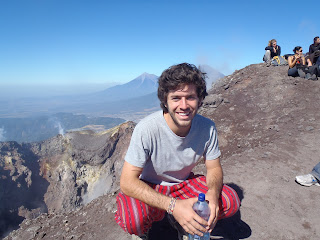 On our second day in Antigua, we woke up early, leaving our hostel at 6am, to climb to the crater of the still active Volcano Pacaya. Just last year, Pacaya had an extremely large explosion, completely destroying multiple nearby villages and claiming the lives of more than 100 people.
On our second day in Antigua, we woke up early, leaving our hostel at 6am, to climb to the crater of the still active Volcano Pacaya. Just last year, Pacaya had an extremely large explosion, completely destroying multiple nearby villages and claiming the lives of more than 100 people. This is a view from a little over halfway up Volcano Pacaya. The closest volcano is Volcano Acatenango. The other two, to the left are Volcano Fuego (still active, as you can see) and Volcano Agua. Antigua, where we spent the entire New Year’s vacation, is on the other side of Acatenango, nestled in a valley in between all three volcanoes.


 This is a panoramic view across all the entire crater. While we did make it to summit of Volcano Pacaya, it is impossible and way to dangerous to go down into the crater itself. As you can see, especially towards the left, it is still constantly steaming and releasing huge amounts of sulfuric vapor.
This is a panoramic view across all the entire crater. While we did make it to summit of Volcano Pacaya, it is impossible and way to dangerous to go down into the crater itself. As you can see, especially towards the left, it is still constantly steaming and releasing huge amounts of sulfuric vapor.


 Although most of last year’s eruption’s force went in the other direction, in this photo the path traveled by the now-cooled lava (the black veins stretching across the otherwise green landscape) is obvious. Both the randomness of where the lava flows and the complete destruction it brings are stark and frightening to the Guatemalan communities near the volcano.
Although most of last year’s eruption’s force went in the other direction, in this photo the path traveled by the now-cooled lava (the black veins stretching across the otherwise green landscape) is obvious. Both the randomness of where the lava flows and the complete destruction it brings are stark and frightening to the Guatemalan communities near the volcano.

 That’s us celebrating for a brief moment our ascent and descent of Volcano Pacaya. Because of the looseness of the volcanic rock, it feels like every step up you take, you slide back down two, and although the descent is much faster, you don’t feel any more secure while slipping and sliding your way back down the volcano laboring just to stay upright.
That’s us celebrating for a brief moment our ascent and descent of Volcano Pacaya. Because of the looseness of the volcanic rock, it feels like every step up you take, you slide back down two, and although the descent is much faster, you don’t feel any more secure while slipping and sliding your way back down the volcano laboring just to stay upright.
Max, sorry that it's taken so long to respond to your blog. Great stories, great pictures, great trip! I'll email more. Love ya, dad
ReplyDelete